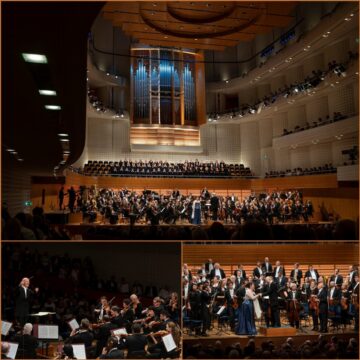« The true paradises are paradises we have lost » (Marcel Proust, Time Regained)
The Lucerne Festival is a noble phoenix: figurehead of musical Europe, resurrected twenty years ago by the no less phoenix Claudio Abbado, each year it welcomes the best orchestras in the world, within a prestigious hall imagined by Jean Nouvel, ideally located on the shores of Lake Lucerne. The Lucerne Festival Orchestra is made of the best musicians from the best European orchestras, simply moved by the pleasure of "making music together", as Abbado liked to repeat, traditionally opens the season, with this year the Estonian conductor Paavo Järvi, replacing Riccardo Chailly, suffering. In such a context, writing a critical article, faced with such a level of excellence, could be a simple exercise in dithyramb. But precisely: the tour de force of these artists consists in bringing us into the beyond of music and art, so much the mastery of the score and the virtuosity, raised to this stratospheric level, allow us to deal with the spiritual power and the emotional experience which emerges from these concerts.
This opening night of the 2023 season, placed under the theme of "Paradise", is no exception to the rule. Gustav Mahler's Third Symphony in D Minor is without doubt one of the most colossal symphonies in the repertoire. Only Havergal Brian's Gothic Symphony exceeds it in duration. The musical subject, the philosophical basis of the work (a sort of panpsychic Nietzschean naturalism stemming from the thought of Gustav Theodor Fechner), the excess of the orchestral force make this masterpiece a touchstone of all great orchestras of the world. In Lucerne itself resounded in 2007 a moving and hallucinatory Third conducted by Abbado. It will be impossible to compare the two approaches, so much Paavo Järvi, in turn, enters into the legend of the great visions of the work, emphasizing not the philosophical subject (the symphony was supposed to depict the awakening of Nature, from its simplest forms to the triumphant Spirit, in a glorification of all living creatures!) but on a human, deeply human story. And if a nervous emotion grips us from the first bars, it is because the conductor knows how to find the miracle of the intimate universality that inhabits Mahler’s score and the composer, like the famous French writer Victor Hugo, knows how to talk about us when he talks about himself.
Telluric. It's a symphony of percussion and heartbeats. From the outset, something disturbs, something deleterious, the rumble of the "It", a journey punctuated by doubts and restrained resentment. The percussion beats wildly, while the solo violin combines the heart and the spirit. Järvi's direction draws our attention with his art of creating silences. He makes the orchestra breathe, yet tortured, suffocated, overwhelmed by reminiscences not of nascent Nature, but by something that evokes childhood, or a distant past of which we do not know what to do or think. The flutes are amazingly beautiful. Emotion, again. How do strings achieve such effects? The conductor captures the contrasts of this flowing movement, between elegance, transparency and serenity. There is however no complacency, and Järvi refuses any exuberant sentimentality (far from Bernstein!). He knows how to impose a dry, precise, uncompromising direction, sometimes reminiscent of… Mitropoulous! And that is what is moving. The sound and the fury, intimate cataclysms, this first movement impresses with its foundation, its hollowed, emaciated silences, its permanent fight with the past. Nothing metaphysical, it's human, tortured, tortuous, crushing any hint of nostalgia. In a martial way, it is a force that goes, without pathos, like a cavalry. We assume the attachment to the earth, far from any metaphysical ambition, we struggle in passages sent prestissimo, in a breathless way. After the recapitulation of the main theme, we let ourselves go more, and the Estonian conductor explores even the slightest silences : what chance should we give to memories? Should they be destroyed? Should we look at them with amusement, candor or irony? Should we discuss with the unspoken? Walk, always walk. It is suffocating in beauty and rough sobriety. We hold back the applause after such an emotionally draining move.
After such a race to the abyss, the second movement gives way to a form of appeased sweetness, even tenderness. We now welcome the past but in a distanced caress… Do you want a little marshmallow? No, thanks. In a form of schizophrenic struggle, the desks to the left of the conductor refuse all pain, while the strings on the right want to languish, extend, wait. And the solo violin persists in tempting the devil, sawing the last strings of the Fates.
The third movement takes on good-natured and mocking airs, but the harps breathe in an unspeakable poetry. The horns chirp, in their marked trills. The hero growls and thunders, while Reinhold Friedrich's trumpet, excellent as always, endlessly anticipates the memories of the cavalry fanfares of the Fifth Symphony, while the sound of the posthorn rises, not in backstage, but behind the organ, giving this distant air a heavenly and ghostly presence: do you hear this lullaby by Brahms, caressed by the carpet of strings? Do you accept this new waltz? Don't turn around and crumple the old papers. The end, conducted with a bang once again, refuses the spectacular usually proposed by the conductors. This is how it is: things are, leave the past behind the organs.
Mahler's Third Symphony, as we know, is a gigantic hymn to nature, a "world" symphony. When the seraphic voice of the contralto Wiebke Lehmkuhl begins to sing the extract from Nietzsche's Zarathustra, with intelligence and mastery, we better understand the primary meaning of the philosopher's text:
« O Man! Take heed! What does the deep midnight say? ‘I was asleep, asleep –, I have awoken from deep dreams: – The world is deep, And deeper than the day imagined. Deep is its grief! Joy, deeper still than heartache! Grief says: Perish! But all joy seeks eternity –, – seeks deep, deep eternity! »1
Mahler answers like Oedipus facing the Sphinx: “Man”! It is indeed a hymn to man and to his unfathomable depth, to his unconscious, perhaps more than a long deployment on the origin of the spirit. In this literal sense, the melodic line of the contralto is ideally sung, it is not the poignant tearing of Kathleen Ferrier nor the flame of soprano Petra Lang, but the text is sung with clarity, readability and incarnation. Special mention to the Luzerner Kantorei children's choir and the Bavarian Radio women's choir, well placed, balanced, whose lyrics quote the Wunderhorn and the finale of the Fourth Symphony, in a kind of vision of Paradise, but once again, the conductor surprises us, in a darker, almost funereal approach to these vocal parts, which begin the concluding and monumental Adagio.
In a long rise of emotion, Järvi manages not to weigh down the line or make this magnificent finale more solemn than it is. On the contrary, he gives a decanted vision of it, with chamber music colors, and many times, we hear like reminiscences of the adagio of Schubert's String Quintet in C major. Lucas Macías Navarro's oboe is stunningly beautiful. Far from any spectacular vitalist celebration, the conductor and his orchestra build a humanist approach and let us perceive all the themes that have marked out the symphony, fractal of life. This work-universe then becomes a reflection of our turpitudes, just as much as metamusic : what will the absence of music be like, when silence invades the room, still dumbfounded by the implacable and specular discourse to which it comes? to attend?
Listen to the silence, listen to these worried echoes, look at this nostalgia, without complacency. It is indeed man and art that look at each other, it is indeed music that looks at itself and recaptures life to make it a work of art. The adagio gives all this to see and hear, in this upward movement, a hero's life, ours, death and transfiguration, ours, where like Baudelaire, the composer draws his "decomposed loves". So one last time, like Orpheus turning on Eurydice, you have to make up your mind to let go of the shadows to regain the light, in D major : the trumpets let their hymn burst, a hymn to art, which allows, at the end of a path in chiaroscuro, to say to oneself, like Stendhal that “Good music makes no mistake and goes straight to the bottom of the soul to look for the sorrow that devours us »
Philippe Rosset
August, 11th 2023
August, 11th 2023
1 English translation by Richard Stokes, author of The Book of Lieder (Faber, 2005)



